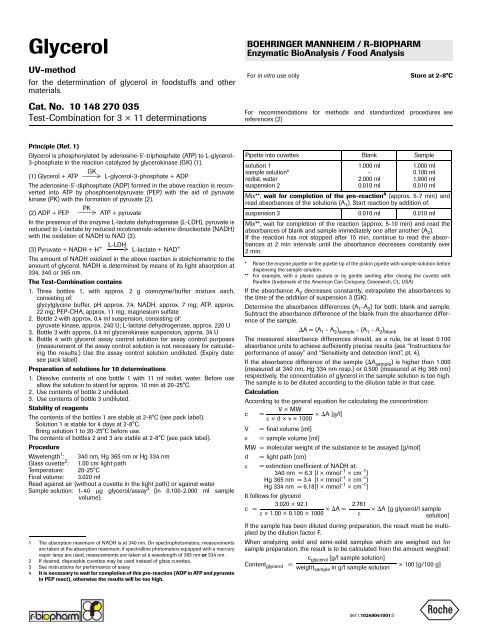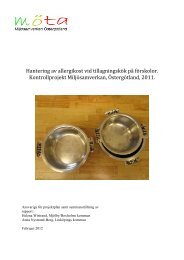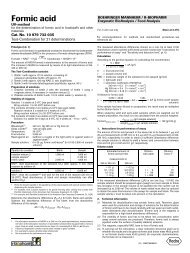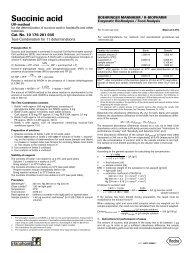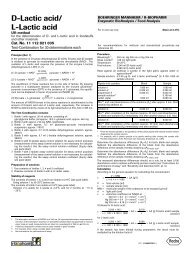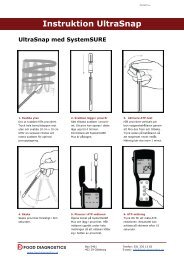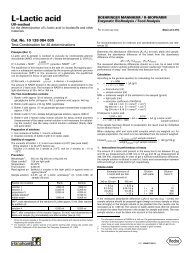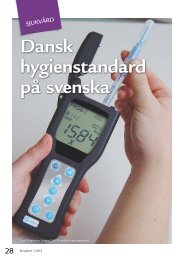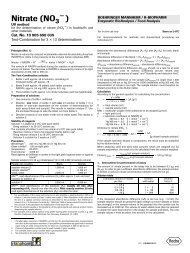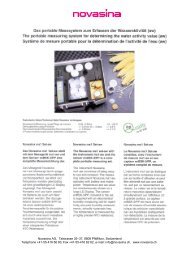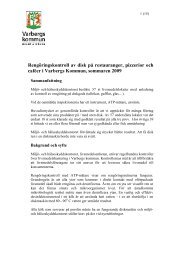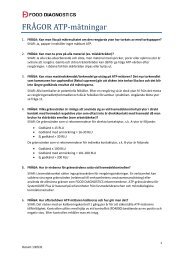Glycerol assay control solution - Food Diagnostics
Glycerol assay control solution - Food Diagnostics
Glycerol assay control solution - Food Diagnostics
You also want an ePaper? Increase the reach of your titles
YUMPU automatically turns print PDFs into web optimized ePapers that Google loves.
<strong>Glycerol</strong>UV-methodfor the determination of glycerol in foodstuffs and othermaterials.Cat. No. 10 148 270 035Test-Combination for 3 × 11 determinationsBOEHRINGER MANNHEIM / R-BIOPHARMEnzymatic BioAnalysis / <strong>Food</strong> AnalysisFor in vitro use onlyStore at 2-8°CFor recommendations for methods and standardized procedures seereferences (2)Principle (Ref. 1)<strong>Glycerol</strong> is phosphorylated by adenosine-5'-triphosphate (ATP) to L-glycerol-3-phosphate in the reaction catalyzed by glycerokinase (GK) (1).GK(1) <strong>Glycerol</strong> + ATP L-glycerol-3-phosphate + ADPThe adenosine-5'-diphosphate (ADP) formed in the above reaction is reconvertedinto ATP by phosphoenolpyruvate (PEP) with the aid of pyruvatekinase (PK) with the formation of pyruvate (2).PK(2) ADP + PEP ATP + pyruvateIn the presence of the enzyme L-lactate dehydrogenase (L-LDH), pyruvate isreduced to L-lactate by reduced nicotinamide-adenine dinucleotide (NADH)with the oxidation of NADH to NAD (3).(3) Pyruvate + NADH + H + L-LDH L-lactate + NAD + 2min.The amount of NADH oxidized in the above reaction is stoichiometric to theamount of glycerol. NADH is determined by means of its light absorption at * Rinse the enzyme pipette or the pipette tip of the piston pipette with sample <strong>solution</strong> beforedispensing the sample <strong>solution</strong>.334, 340 or 365 nm.** For example, with a plastic spatula or by gentle swirling after closing the cuvette withThe Test-Combination contains1. Three bottles 1, with approx. 2 g coenzyme/buffer mixture each,consisting of:Parafilm (trademark of the American Can Company, Greenwich, Ct., USA)If the absorbance A 2 decreases constantly, extrapolate the absorbances tothe time of the addition of suspension 3 (GK).glycylglycine buffer, pH approx. 7.4; NADH, approx. 7 mg; ATP, approx. Determine the absorbance differences (A 1 -A 2 ) for both, blank and sample.22 mg; PEP-CHA, approx. 11 mg; magnesium sulfateSubtract the absorbance difference of the blank from the absorbance differenceof the sample.2. Bottle 2 with approx. 0.4 ml suspension, consisting of:pyruvate kinase, approx. 240 U; L-lactate dehydrogenase, approx. 220 U3. Bottle 3 with approx. 0.4 ml glycerokinase suspension, approx. 34 UA = (A 1 - A 2 ) sample - (A 1 - A 2 ) blank4. Bottle 4 with glycerol <strong>assay</strong> <strong>control</strong> <strong>solution</strong> for <strong>assay</strong> <strong>control</strong> purposes(measurement of the <strong>assay</strong> <strong>control</strong> <strong>solution</strong> is not necessary for calculatingthe results.) Use the <strong>assay</strong> <strong>control</strong> <strong>solution</strong> undiluted. (Expiry date:see pack label)Preparation of <strong>solution</strong>s for 10 determinationsThe measured absorbance differences should, as a rule, be at least 0.100absorbance units to achieve sufficiently precise results (see “Instructions forperformance of <strong>assay</strong>” and “Sensitivity and detection limit”, pt. 4).If the absorbance difference of the sample (A sample ) is higher than 1.000(measured at 340 nm, Hg 334 nm resp.) or 0.500 (measured at Hg 365 nm)1. Dissolve contents of one bottle 1 with 11 ml redist. water. Before use respectively, the concentration of glycerol in the sample <strong>solution</strong> is too high.allow the <strong>solution</strong> to stand for approx. 10 min at 20-25°C.The sample is to be diluted according to the dilution table in that case.2. Use contents of bottle 2 undiluted.3. Use contents of bottle 3 undiluted.CalculationAccording to the general equation for calculating the concentration:Stability of reagentsV × MWc =× A [g/l]The contents of the bottles 1 are stable at 2-8°C (see pack label). × d × v × 1000Solution 1 is stable for 4 days at 2-8°C.Bring <strong>solution</strong> 1 to 20-25°C before use.V = final volume [ml]The contents of bottles 2 and 3 are stable at 2-8°C (see pack label).v = sample volume [ml]ProcedureMW = molecular weight of the substance to be <strong>assay</strong>ed [g/mol]Wavelength 1 : 340 nm, Hg 365 nm or Hg 334 nmd = light path [cm]Glass cuvette 2 : 1.00 cm light pathTemperature: 20-25°CFinal volume: 3.020 mlRead against air (without a cuvette in the light path) or against waterSample <strong>solution</strong>: 1-40 g glycerol/<strong>assay</strong> 3 (in 0.100-2.000 ml samplevolume).1 The absorption maximum of NADH is at 340 nm. On spectrophotometers, measurementsare taken at the absorption maximum; if spectralline photometers equipped with a mercuryvapor lamp are used, measurements are taken at a wavelength of 365 nm or 334 nm.2 If desired, disposable cuvettes may be used instead of glass cuvettes.3 See instructions for performance of <strong>assay</strong>4 It is necessary to wait for completion of this pre-reaction (ADP in ATP and pyruvatein PEP react), otherwise the results will be too high.Pipette into cuvettes Blank Sample<strong>solution</strong> 1sample <strong>solution</strong>*redist. watersuspension 21.000 ml-2.000 ml0.010 ml= extinction coefficient of NADH at:340 nm = 6.3 [l × mmol -1 × cm -1 ]Hg 365 nm = 3.4 [l × mmol -1 × cm -1 ]Hg 334 nm = 6.18[l × mmol -1 × cm -1 ]1.000 ml0.100 ml1.900 ml0.010 mlMix**, wait for completion of the pre-reaction 4 (approx. 5-7 min) andread absorbances of the <strong>solution</strong>s (A 1 ). Start reaction by addition of:suspension 3 0.010 ml 0.010 mlMix**, wait for completion of the reaction (approx. 5-10 min) and read theabsorbances of blank and sample immediately one after another (A 2 ).If the reaction has not stopped after 15 min, continue to read the absorbancesat 2 min intervals until the absorbance decreases constantly overIt follows for glycerol3.020 × 92.1c =× A = 2.781 × A [g glycerol/l sample × 1.00 × 0.100 × 1000<strong>solution</strong>]If the sample has been diluted during preparation, the result must be multipliedby the dilution factor F.When analyzing solid and semi-solid samples which are weighed out forsample preparation, the result is to be calculated from the amount weighed:c glycerol [g/l sample <strong>solution</strong>]Content glycerol =weight× 100 [g/100 g]sample in g/l sample <strong>solution</strong>0611.10249041001➄
1. Instructions for performance of <strong>assay</strong>The glycerol content present in the <strong>assay</strong> has to be between 1 g and 40 g.In order to get a sufficient absorbance difference, the sample <strong>solution</strong> isdiluted to yield a glycerol concentration between 0.04 and 0.4 g/l.Dilution tableEstimated amount ofglycerol per liter 0.4 g0.4-4.0 g4.0-40 g 40 gDilutionwith water-1 + 91 + 991 + 999Dilutionfactor F1101001000If the measured absorbance difference (A) is too low (e.g. 0.100), thesample <strong>solution</strong> should be prepared again (weigh out more sample or diluteless strongly) or the sample volume to be pipetted into the cuvette can beincreased up to 2.000 ml. The volume of water added must then be reducedso as to obtain the same final volume in the <strong>assay</strong>s for sample and blank.The new sample volume v must be taken into account in the calculation.2. Technical informationIt is necessary to wait for the completion of the pre-reaction after the additionof suspension 2 (PK/L-LDH).3. Specificity (Ref. 1)The method is specific for glycerol. Dihydroxyacetone is not converted underthe given conditions.In the analysis of commercial glycerol results of approx. 100% (calculated onthe water-free substance) have to be expected.4. Sensitivity and detection limitThe smallest differentiating absorbance for the procedure is 0.005 absorbanceunits. This corresponds to a maximum sample volume v = 2.000 ml andmeasurement at 340 of a glycerol concentration of 0.1 mg/l sample <strong>solution</strong>(if v = 0.100 ml, this corresponds to 2 mg/l sample <strong>solution</strong>).The detection limit of 0.4 mg/l is derived from the absorbance difference of0.020 (as measured at 340 nm) and a maximum sample volume v = 2.000 ml.5. LinearityLinearity of the determination exists from approx. 1 g glycerol/<strong>assay</strong>(0.4 mg glycerol/l sample <strong>solution</strong>; sample volume v = 2.000 ml) to 40 gglycerol/<strong>assay</strong> (0.4 g glycerol/l sample <strong>solution</strong>; sample volume v =0.100 ml).6. PrecisionIn a double determination using one sample <strong>solution</strong>, a difference of 0.005 to0.010 absorbance units may occur. With a sample volume of v = 0.100 mland measurement at 340 nm, this corresponds to a glycerol concentration ofapprox. 2-5 mg/l. (If the sample is diluted during sample preparation, theresult has to be multiplied by the dilution factor F. If the sample is weighed infor sample preparation, e.g. using 1 g sample/100 ml = 10 g/l, a difference of0.02-0.05 g/100 g can be expected.)The following data have been published in the literature:CV = 2.5 % in series serumCV = 2.59 % from day to day serum (Ref. 1.2)Pastilles m = 1.482 g/100 g r = 0.0393 g/100/g R = 0.1484 g/100 gStandard m = 0.206 g/l r = 0.0047 g/l R = 0.0115 g/lWhite grape juice m = 0.613 g/l r = 0.0138 g/l R = 0.0337 g/lRed grape juice m = 0.907 g/l r = 0.0251 g/l R = 0.0511 g/lWhite wine m = 6.050 g/l r = 0.1154 g/l R = 0.5002 g/lRed wine m = 16.57 g/l r = 0.3166 g/l R = 1.1240 g/l(Ref. 3.8)7. Interference/sources of errorThe slow hydrolysis of ATP and phosphoenolpyruvate as well as the air oxidationof NADH results in a slow creep reaction which can be taken intoaccount by extrapolation. An extrapolation is not absolutely necessary if theabsorbances of blank and sample are measured immediately one afteranother.8. Recognizing interference during the <strong>assay</strong> procedure8.1 If the conversion of glycerol has been completed according to the timegiven under “Procedure“ it can be concluded in general that no interferencehas occurred.8.2 On completion of the reaction, the determination can be restarted byadding glycerol (qualitative or quantitative): if the absorbance is alteredsubsequent to the addition of the standard material, this is also anindication that no interference has occurred.8.3 Operator error or interference of the determination through the presenceof substances contained in the sample can be recognized by carryingout a double determination using two different sample volumes (e.g.0.100 ml and 0.200 ml): the measured differences in absorbance shouldbe proportional to the sample volumes used.When analyzing solid samples, it is recommended that differentquantities (e.g. 1 g and 2 g) be weighed into 100 ml volumetric flasks.The absorbance differences measured and the weights of sample usedshould be proportional for identical sample volumes.8.4 Possible interference caused by substances contained in the sample canbe recognized by using an internal standard as a <strong>control</strong>: in addition tothe sample, blank and standard determinations, a further determinationshould be carried out with sample and <strong>assay</strong> <strong>control</strong> <strong>solution</strong> in thesame <strong>assay</strong>. The recovery can then be calculated from the absorbancedifferences measured.8.5 Possible losses during the determination can be recognized by carryingout recovery tests: the sample should be prepared and analyzed withand without added standard material. The additive should be recoveredquantitatively within the error range of the method.9. Reagent hazardThe reagents used in the determination of glycerol contain hazardous materialsin the sense of the Hazardous Substances Regulations, the ChemicalsLaw or EC Regulations 67/548 and 99/45 and subsequent alteration, supplementationand adaptation guidelines. Please refer to the safety date sheet orthe labels of the affected vials for further information.10. General information on sample preparationIn carrying out the <strong>assay</strong>:Use clear, colorless and practically neutral liquid samples directly, orafter dilution according to the dilution table, and of a volume up to 2.000 ml;Filter turbid <strong>solution</strong>s;Degas samples containing carbon dioxide (e.g. by filtration);Adjust acid samples to approx. pH 8 by adding sodium or potassiumhydroxide <strong>solution</strong>;Adjust acid and weakly colored samples to approx. pH 8 by addingsodium or potassium hydroxide <strong>solution</strong> and incubate for approx. 15 min;Treat “strongly colored“ samples that are used undiluted or with a highersample volume with polyvinylpolypyrrolidone (PVPP) or with polyamide, e.g.1g/100 ml;Crush or homogenize solid or semi-solid samples, extract with water ordissolve in water and filter if necessary; resp. remove turbidities or dyestuffsby Carrez clarification;Deproteinize samples containing protein with Carrez reagents;Extract samples containing fat with hot water (extraction temperatureshould be above the melting point of the fat involved). Cool to allow the fatto separate, make up to the mark, place the volumetric flask in an ice bathfor 15 min and filter; alternatively clarify with Carrez-<strong>solution</strong>s after theextraction with hot water.Carrez clarification:Pipette the liquid sample into a 100 ml volumetric flask which containsapprox. 60 ml redist.water, or weigh sufficient quantity of the sample into a100 ml volumetric flask and add approx. 60 ml redist. water. Subsequently,carefully add 5 ml Carrez-I-<strong>solution</strong> (potassium hexacyanoferrate(II) (ferrocyanide),85 mM = 3.60 g K 4 [Fe(CN) 6 ] × 3 H 2 O/100 ml) and 5 ml Carrez-II<strong>solution</strong>(zinc sulfate, 250 mM = 7.20 g ZnSO 4 × 7 H 2 O/100 ml). Adjust to pH7.5-8.5 with sodium hydroxide (0.1 M; e.g. 10 ml). Mix after each addition. Fillthe volumetric flask to the mark, mix and filter.2
11. Application examplesDetermination of glycerol in fruit juicesDilute the sample to yield a glycerol concentration of less than 0.4 g/l (seedilution table).Filter turbid juices. Use the clear <strong>solution</strong> for the <strong>assay</strong>, even if it is slightlycolored.When analyzing strongly colored juices (e.g., sour cherry juice, red grapejuice), decolorize the sample as follows:Mix 10 ml of juice and approx. 0.1 g of polyamide powder or polyvinylpolypyrrolidone(PVPP), stir for 1 min and filter. Use the clear <strong>solution</strong>, which maybe slightly colored, for the <strong>assay</strong>.Determination of glycerol in wineDilute the sample according to the dilution table.In general, red wine can also be analyzed without decolorization.Determination of glycerol in beerTo remove the carbonic acid, stir about 5-10 ml of beer for approx. 1 minusing a glass rod or filter; dilute the largely CO 2 -free sample according tothe dilution table.Determination of glycerol in marzipanRemove chocolate coating of the marzipan if necessary. Accurately weighapprox. 1 g of marzipan into a small porcelain cup containing approx. 2 gsea-sand, grind thoroughly, mix with approx. 50 ml water and incubate atapprox. 60°C for 20 min. Pour supernatant <strong>solution</strong> into a 100 ml volumetricflask. Wash the residue (sea-sand) twice with portions of 10 ml water eachand transfer the wash <strong>solution</strong> into the volumetric flask. Allow the <strong>solution</strong> inthe volumetric flask to cool to 20-25°C and fill up to the mark with water. Forseparation of fat, place in a refrigerator for 15 min. Filter the <strong>solution</strong>,centrifuge, if necessary, at 3000 rpm. Use the largely clear <strong>solution</strong> for the<strong>assay</strong>, dilute, if necessary (see dilution table).Determination of glycerol in tobacco productsMix and mince sample thoroughly (grain size max. 0.2 mm). Accuratelyweigh approx. 1 g into a 100 ml volumetric flask. After addition of approx.70 ml water stir vigorously (magnetic stirrer) for approx. 1 h at 20-25°C. Fillup to the mark with water, mix and filter.Pipette 25 ml filtrate into a 50 ml volumetric flask, add successively and mixafter each addition: 5 ml Carrez-I-<strong>solution</strong> (3.60 g K 4 [Fe(CN 6 )] × 3 H 2 O/100 ml), 5 ml Carrez-II-<strong>solution</strong> (7.20 g ZnSO 4 × 7H 2 O/100 ml) and 10 mlNaOH (0.1 M). Fill up to the mark with water, mix and filter. Use thefiltrate for the <strong>assay</strong> (0.100-0.500 ml).12. Further applicationsThe method may also be used in the examination of paper (Ref. 2.1), cosmetics(Ref. 4.1), pharmaceuticals (Ref. 4.5, 4.6), and in research when analyzingbiological samples. For details of sampling, treatment and stability of thesample see Ref. 1.2.12.1 Determination of glycerol in cosmeticsDetermination of glycerol in skin tonicDilute sample as far as the glycerol concentration lies under 0.4 g/l. Useundiluted or diluted sample for the <strong>assay</strong>.Determination of glycerol in pre-shave, after-shaveIf the after-shave is mixable with water without turbidity, proceed accordingto skin tonic.If a turbidity occurs after diluting the after-shave with water, this turbidityhas to be removed with polyamide or activated charcoal:Mix 1.0 ml after-shave with 9.0 ml water, add 100 mg polyamide or activatedcharcoal, mix again and filter (dilution factor: 10).If the glycerol concentration in the filtrate is lower than 0.02 g/l, the samplevolume which has to be pipetted into the <strong>assay</strong> can be increased up to2.000 ml. The quantity of water which has to be added must be reducedaccordingly.Determination of glycerol in skin creamAccurately weigh approx. 1 g skin cream into a 100 ml volumetric flask, addapprox. 70 ml water and keep at 60°C for 30 min, while occasionally shaking.After cooling to 20-25°C, fill up to the mark with water. Place volumetric flaskin a refrigerator or better in an ice-bath for 15 min. Filter or centrifuge<strong>solution</strong>. If necessary dilute filtrate or supernatant and use for the <strong>assay</strong>.Determination of glycerol in toothpasteAccurately weigh approx. 1 g toothpaste into 100 ml beaker, add approx.70 ml water and extract for 30 min at 60°C while stirring (heatable magneticstirrer). Transfer suspension into centrifuge tube. Pour the clear supernatantinto a 250 ml volumetric flask after centrifugation. Rinse precipitate withwater into a beaker and repeat extraction one to two times. Fill up thevolumetric flask to the mark, filter, if necessary.Depending on the glycerol concentration use clear <strong>solution</strong>, respectively thefiltrate directly or after dilution with water for the determination. If theglycerol concentration in the clear <strong>solution</strong> or in the filtrate is lower than0.02 g/l the sample volume, which has to be pipetted into the <strong>assay</strong>, can beincreased up to 2.000 ml. The water quantity, to be added, has to be reducedaccordingly.Alternatively the Carrez clarification may be used for the preparation of thetoothpaste sample.Determination of glycerol in soapAccurately weigh approx. 1 g grated soap into a beaker, add approx. 50 mlHCI (0.1 M) and while stirring rigorously incubate on a heatable magneticstirrer until boiling. Transfer aqueous phase with a pipette into a 100 mlvolumetric flask. Repeat extraction with approx. 30 ml HCI (0.1 M).Bring volumetric flask to 20-25°C and fill up to the mark with redist. water.Place volumetric flask in an ice-bath or refrigerator for 15 min. Filter througha fluted filter. Use filtrate, depending on the expected glycerol concentration,diluted or undiluted for the determination.If the glycerol concentration is lower than 0.02 g/l, the volume which has tobe pipetted into the <strong>assay</strong> can be increased up to 2.000 ml. In this case thevolume of the water quantity to be added has to be reduced accordingly.12.2 Determination of glycerol in fermentation samples and cellculture mediaPlace the sample (after centrifugation, if necessary) in a water-bath at 80°Cfor 15 min to stop enzymatic reactions. Centrifuge and use the supernatant(diluted according to the dilution table, if necessary) for the <strong>assay</strong>.Alternatively, deproteinization can be carried out with perchloric acid or withCarrez-<strong>solution</strong>s. See the above-mentioned examples.Homogenize gelantinous agar media with water and treat further asdescribed.3
References1.1 Kreutz, F.H. (1962) Enzymatische Glycerinbestimmung, Klin. Wochenschrift 40, 362-3631.2 Eggstein, M. & Kuhlmann, E. (1974) in Methoden der enzymatischen Analyse (Bergmeyer,H.U., Hrsg.) 3. Aufl., Bd. 2, S. 1871-1877, Verlag Chemie, Weinheim, and (1974) inMethods of Enzymatic Analysis (Bergmeyer, H. U., ed.) 2nd ed., vol. 4, pp. 1825-1831;Verlag Chemie, Weinheim/Academic Press, Inc., New York and London1.3 Wieland, O.H. (1984) in Methods of Enzymatic Analysis (Bergmeyer, H. U. ed.) 3rd ed.,vol. VI, pp. 504-510, Verlag Chemie, Weinheim, Deerfield Beach/Florida, Basel2.1 Untersuchung von Papieren, Kartons und Pappe für Lebensmittel-Verpackungen (gem.Empf. XXXVI der Kunststoffkommission des Bundesgesundheitsamtes) Kapitel 8(Methoden), Pkt. 3.5.2. (März 1979)2.2 Methodenbuch für Weinanalysen in Österreich (1980), herausgegeben von Arbeitsgemeinschaftder Landw. Versuchsanstalten in Österreich (ALVA)2.3 Gombocz, E., Hellwig, E., Vojir, F. & Petuely, F. (1981) Deutsche Lebensmittel-Rundschau77, 82.4 Brautechnische Analysenmethoden, Band III, S. 553-556 (1982), Methodensammlungder Mitteleuropäischen Brautechnischen Analysenkommission (MEBAK), herausgegebenvon F. Drawert im Selbstverlag der MEBAK, Freising2.5 Schweizerisches Lebensmittelbuch, Kapitel 61B (Enzymatische Bestimmungen)/2.2(1985), Kapitel 28A (Frucht- und Gemüsesäfte, Fruchtnektare, Fruchtsirupe, Konzentrateund Pulver)/12.3 (1994), Kapitel 30 (Wein)/40 (1967), Kapitel 30A (Wein)/40 (1973)2.6 Recueil des méthodes internationales d'analyse des vins et des moûts, Complément n°1 à l'édition officielle de juin 1990, OFFICE INTERNATIONAL DELA VIGNE ETDUVIN, S.149-1513.1 Drawert, F. & Kupfer, G. (1963) Enzymatische Analysen, I. Mitteilung: Bestimmung vonGlycerin in Weinen und Traubenmosten, Zeitschrift für Lebensmittel-Untersuchung und-Forschung, 123, 211-2173.2 Berner, G. & Guhr, G. (1969) Freies Glycerin und Gesamt-Glycerin in Monoglyceridenund in Partialester-Gemischen; ein Vergleich der enzymatischen Glycerin-Bestimmungmit chemischen Methoden, Fette-Seifen-Anstrichmittel-Die Ernährungsindustrie 71,459-4643.3 Holbach, B. & Woller, R. (1976) über den Zusammenhang zwischen Botrytisbefall vonTrauben und den Glycerin- sowie Gluconsäuregehalt von Wein, Weinwissenschaft 31,202-2143.4 Holbach, B. & Woller, R. (1977) Vergleichende Glycerinbestimmung im Wein nach derMethode Rebelein und der enzymatischen Methode, Weinwissenschaft 32, 212-2183.5 Wagner, K. & Kreutzer, P. (1978) Beitrag zur Glycerinbestimmung in Wein, Likörwein undweinhaltigen Getränken, Weinwissenschaft 33, 109-1133.6 Mändl, B., Wullinger, F., Fischer, A. & Piendl, A. (1970) Weitere Ergebnisse über denGehalt verschiedener Biersorten an Glycerin, Pyruvat, Citrat und Malat, Brauwissenschaft23, 11-183.7 Klopper, W.J., Angelino, S.A.G.F., Tuning, B. & Vermeire, H.A. (1986) Organic acids andglycerol in beer, J. Inst. Brew. 92, 225-2283.8 Walter, E. & Kohler, P. (1985) Ringversuch für die enzymatische Bestimmung von Glycerin,Z. Lebensm. Unters. Forsch. 180, 121-1253.9 Plessi, M., Monzani, A., & Coppini, D. (1988) Determination of the Monosaccharide andAlcohol Content of Balsamic and Other Vinegars by Enzymatic Methods, Agric. Biol.Chem. 52, 25-303.10 Tamminga-Groenveld, T., Westra, A.M. & Strikwerda, K. (1989) Enzymatisch enHogedruk Vloeistofchromatografisch Onderzoek van de Gehalten aan <strong>Glycerol</strong> inJenever, Vieux en Beerenburg, De Ware(n)-Chemicus 19, 109-1203.11 Huidobro, J.F., Rea, M.E., Branquinho de Andrade, P.C., Sancho, M.T., Muniategui, S. &Simal-Lozano, J. (1993) Enzymatic determination of glycerol in honey, J.Agric.<strong>Food</strong>Chem. 41, 557-559.3.12 Russmann, H. (1998) Hefen und Glycerin in Blütenhonigen - Nachweis einer Gärungoder einer abgestoppten Gärung, Lebensmittelchemie, 52, 116-1174.1 Henniger, G. & Boos, H. (1978) Anwendung der enzymatischen Analyse bei der Untersuchungkosmetischer Präparate, dargestellt an einigen Beispielen; Seifen - Öle - Fette- Wachse 104, 159-1644.2 Schmidt, F. H. & von Dahl, K. (1968) Zur Methode der enzymatischen Neutralfettbestimmungin biologischem Material, Z. Klin. Chem. Klin. Biochem. 96, 156-1594.3 Wieland, O. (1957) Biochem. Z. 329, 3134.4 Wieland, O. & Witt, I. (1974), Dihydroxyacetone, in Methoden der enzymatischenAnalyse (Bergmeyer, H.U., Hrsg.) 3. Auflage, Bd. 2, S. 1487, Verlag Chemie, Weinheim,and Wieland, O. (1974) in Methods of Enzymatic Analysis (Bergmeyer, H.U., ed.) 2nd ed.,vol. 4, pp. 1404; Verlag Chemie, Weinheim/Academic Press, Inc., New York and London4.5 Michal, G. (1976) Enzymatische Analyse in der Pharmazie, Acta PharmaceuticaTechnologica, Suppl. 1, S. 151-1624.6 Pfandl, A. & Menschig, D. (1984) Ein Beitrag zur enzymatischen Glycerin- und Ethanolbestimmung,Pharm. Ind. 46, 403-4074
<strong>Glycerol</strong> <strong>assay</strong> <strong>control</strong> <strong>solution</strong> (Bottle 4)Concentration: see bottle label<strong>Glycerol</strong> <strong>assay</strong> <strong>control</strong> <strong>solution</strong> is a stabilized aqueous <strong>solution</strong> of glycerol. Itis used as an <strong>assay</strong> <strong>control</strong> <strong>solution</strong> for the enzymatic determination of glycerolin foodstuffs and other sample materials.Application:1. Addition of glycerol <strong>assay</strong> <strong>control</strong> <strong>solution</strong> to the <strong>assay</strong> mixture:The <strong>assay</strong> <strong>control</strong> <strong>solution</strong> is used for the determination instead of thesample <strong>solution</strong>.2. Restart of the reaction, quantitatively:After completion of the reaction with sample <strong>solution</strong> and measuring of A 2,add 0.050 ml <strong>assay</strong> <strong>control</strong> <strong>solution</strong> to the <strong>assay</strong> mixture. Read absorbanceA 3 after the end of the reaction (approx. 15 min). Calculate the concentrationfrom the difference of (A 2 -A 3 ) according to the general equation forcalculating the concentration. The altered total volume must be taken intoaccount. Because of the dilution of the <strong>assay</strong> mixture by addition of the<strong>assay</strong> <strong>control</strong> <strong>solution</strong>, the result differs insignificantly from the data statedon the bottle label.3. Internal standard:The <strong>assay</strong> <strong>control</strong> <strong>solution</strong> can be used as an internal standard in order tocheck the determination for correct performance (gross errors) and to seewhether the sample <strong>solution</strong> is free from interfering substances:Pipette intocuvettes<strong>solution</strong> 1suspension 2sample <strong>solution</strong><strong>assay</strong> <strong>control</strong> sln.redist. waterBlank Sample Standard Sample +Standard1.000 ml0.010 ml--2.000 ml1.000 ml0.010 ml0.100 ml-1.900 ml1.000 ml0.010 ml-0.100 ml1.900 ml1.000 ml0.010 ml0.050 ml0.050 ml1.900 mlMix, and read absorbances of the <strong>solution</strong>s (A 1 ) after approx. 7 min. Continueas described in the pipetting scheme under “Procedure”. Follow theinstructions given under “Instructions for performance of <strong>assay</strong>” and thefootnotes.The recovery of the standard is calculated according to the followingformula:recovery = 2 × A sample + standard - A samplex 100 [%]A standardR-BIOPHARM AGAn der neuen Bergstraße 17D-64297 DarmstadtPhone + 49 61 51 / 81 02-0Fax + 49 61 51 / 81 02-20www.r-biopharm.com


